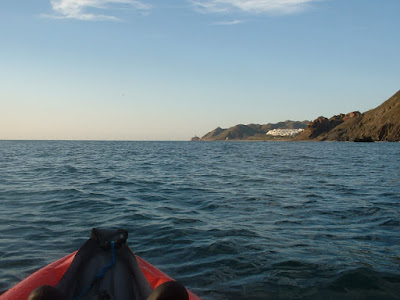I reached there at about 0745h. and there was already quite a contingent of sea anglers fishing from the mole. I was glad of the shelter provided by the mole for launching as there was a bit of swell coming from the north east and a bit of a breeze from the same direction.
Clear of the mole the sea was quite choppy.
The birthday present was a kayak drogue - sea anchor, sea sock, drift anchor, parachute brake are also among many terms used for this bit of kit, but I'm sticking with 'drogue', as it's the shortest. I'm familiar with drogues being used on yachts and motor boats in heavy weather at sea, but I'd never come across a kayak drogue and, for the sort of quiet paddling I do, I did wonder whether I would ever use it. So I did a bit of research and discovered that drogues are used quite regularly by sea anglers fishing from sit-on-top kayaks - mainly to slow down their drift across fishing grounds when it gets a bit windy. This was a bit of an eye opener and, although I'm not an angler, I could now visualize occasions when I might want to use a drogue in open water.
This is the kayak drogue and towline as received. It was labelled as an 18 inch (457 mm) drogue which is the width of the large end when folded flat. When opened out it is like a very large fabric funnel. The loop at the smaller end is for the attachment of a trip & recovery line.
Update (several days later): I've only just noticed that the loop of webbing at the smaller end isn't actually showing in the photograph! It is there, as seen in the next one.
My internet research revealed that a kayak drogue, just used to slow down drift, doesn't necessarily need a very long towline. So I rigged mine on the end of my 4 metre long bow line (the blue one) and used the line supplied with the drogue (the black one) as a trip & recovery line. Drogues, when no longer needed, tow through the water easier pointy end first.
The first trial with the drogue wasn't a great success, as there wasn't enough wind to cause my kayak to pull hard enough to open out the 'funnel'. Later, when the wind freshened considerably, it worked very well as rigged. The Twist was almost stationery in the water with the bow pointing up into the wind. It was a very comfortable feeling and I think that this drogue will become a standard bit of kit on both my kayaks.
Recovery of the drogue, pointy end first. Apparently, among kayaking sea anglers, the jury is 'out' regarding whether a trip & recovery line is really necessary. It should be possible to just paddle forward, pick up the float on the towline and just lift the drogue straight out of the water. That would avoid the possibility of the trip & recovery line fouling the drogue and preventing it from opening - more experimentation is obviously needed in the way the drogue is rigged.
After about 1½ hours of pleasant paddling and messing about I was back on the beach. The shelter from the mole was again welcome, as nearer to the car park the bigger surf would have made landing tricky.
From this point northwards, there is at least 5 kilometres of hotels, apartment blocks, bars, restaurants, clubs and all the various shops which make up Mojácar sea front.
The Twist is not a 'thing of beauty' but she is nimble, responsive and feels safe. That odd looking bow lifts reassuringly over swells and waves.
The view to the south, from where I was parked. This proved to be a nice place for kayaking. Just a bit removed from the main tourist drag, a decent car park (if you get there fairly early) where it's possible to park close to the water and a nice stretch of coastline to paddle along if the conditions are right. I did get as far as that biggest rock sticking out of the sea before the wind freshened too much.
The view to the north from where I was parked. People are now starting to arrive on the beach.
As I was packing up, this sea angler, on a sit-on-top kayak, came paddling in. We had passed each other within hailing/waving distance earlier on and had exchanged greetings. I hadn't been the only kayak on the water that morning.












